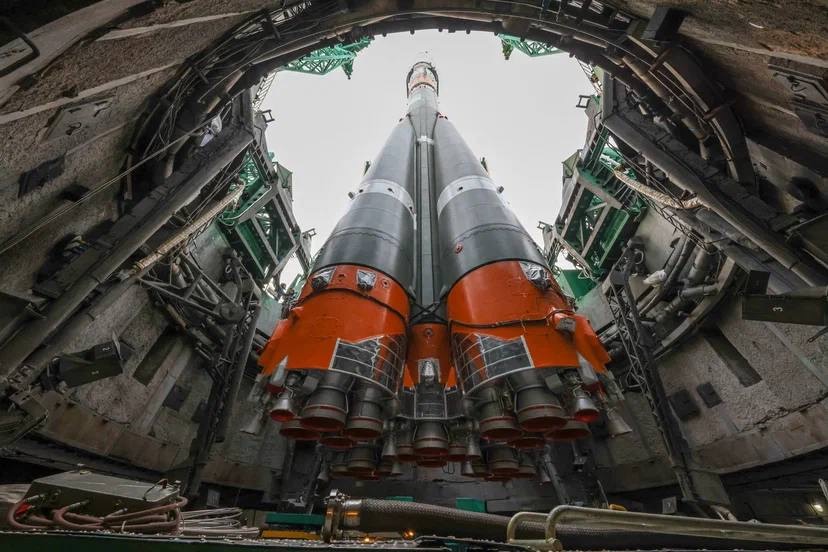
Russia’s space agency said Tuesday that preliminary data suggest a coolant leak on a Progress cargo freighter docked at the International Space Station earlier this month was caused by “external influences” — possibly something that occurred during its launch last year, according to a senior NASA space station manager.
It was the second time in two months that a Russian spacecraft docked at the space station suddenly leaked coolant fluid, following the loss of coolant from a Soyuz crew ferry spacecraft in December. The two leaks were similar, both originating from each spacecraft’s thermal control system, spewing a cloud of frozen coolant into space.
The Progress MS-21 cargo ship undocked from the space station Friday, as scheduled, six days after Russian ground controllers first detected a loss of pressure in the spacecraft’s cooling system. Cameras operated by Russian cosmonauts inside the station and remote controlled cameras outside the complex captured high-resolution images of the Progress MS-21 spacecraft, revealing a 12-millimeter hole where the coolant fluid flowed out of the cooling system Feb. 11.
The Progress MS-21 completed a de-orbit burn Saturday and descended back into the atmosphere over the remote South Pacific Ocean, burning up and discarding several tons of trash and other no-longer-needed items from the space station.
Russia’s space agency, Roscosmos, posted an update on its Telegram channel Tuesday, claiming the preliminary conclusion of the investigation into the damage to the Progress MS-21 supply ship indicated it was caused by an “external influence,” and not a manufacturing defect.
The coolant leaks on the Progress MS-21 cargo spacecraft Feb. 11 and the Soyuz MS-22 crew capsule Dec. 14 were unlike anything that has happened in the more than 25-year history of the space station. Russian space agency managers decided to launch a fresh Soyuz spacecraft to replace the damaged Soyuz MS-22 vehicle after its coolant leak.
“According to preliminary data from RSC Energia (prime contractor for the Soyuz and Progress spacecraft), the Progress MS-21, like the Soyuz MS-22 before, was exposed to external influences,” Roscosmos said. “Such conclusions are made on the basis of photographs that show changes on the outer surface of the ship, including on the radiator of the instrument-aggregate compartment and solar panels.”
Roscosmos said managers cleared the new Soyuz MS-23 spacecraft, a replacement for the damaged Soyuz, for launch Thursday at 7:24 p.m. EST (0024 GMT Friday) on a Soyuz-2.1a rocket.

Ground teams at the Baikonur Cosmodrome in Kazakhstan rolled the new Soyuz MS-23 spacecraft and its Soyuz booster to their launch pad Tuesday. The Soyuz MS-23 capsule, originally slated to launch a crew of three in March, will fly to the station.a few weeks earlier than originally planned without any people on-board.
The Soyuz MS-23 spacecraft is scheduled to autonomously dock at the Poisk module on the Russian segment of the space station at 8:01 p.m. EST Saturday (0101 GMT Sunday). Assuming the new Soyuz completes its automated docking as planned, the damaged Soyuz MS-22 spacecraft will depart the complex next month to head for a parachute-assisted landing in Kazakhstan.
Russian commander Sergey Prokopyev, cosmonaut Dmitri Petelin, and NASA astronaut Frank Rubio will return to Earth on Soyuz MS-23 after the launch of Soyuz MS-24 with their replacement crew in September. Their expedition was extended by six months after Russian space officials shuffled the schedule of missions to the space station in the wake of the Soyuz coolant leak.
Without a functioning internal cooling system, Russian engineers are concerned about overheating of computers and other internal components on the Soyuz MS-22 spacecraft during the flight from the space station back to Earth. Engineers deemed the damaged Soyuz safe enough to use for an emergency evacuation of the space station, but extended the stay of its three-man crew at the complex from March until September, when they will ride the new Soyuz MS-23 spacecraft back to Earth.
Russian officials initially blamed the Soyuz MS-22 coolant leak on a likely impact from a tiny piece of rock from deep space, called a micrometeoroid. After the leak on the Progress cargo freighter earlier his month, it’s not clear if Roscosmos officials still believe in the micrometeoroid explanation for the Soyuz MS-22 leak.

Dana Weigel, NASA’s deputy program manager for the ISS, said Tuesday that the U.S. space agency is also analyzing data to find the cause of the leaks.
She told reporters she did not interpret the Russian space agency’s statement about an “external influence” on Progress MS-21 as specifically pointing to micrometeoroid damage.
“I actually don’t interpret that was micrometeoroid damage over the spacecraft,” Weigel said, referring to the Roscosmos statement on Progress MS-21. “I think what they’re really trying to understand is are there any signs or signatures that somewhere along the spacecraft’s journey, whether it’s launch or launch vehicle separation, there’s some other external influence or damage that could have occurred that could have been a factor there.”
The Progress MS-21 cargo ship launched in October, carrying fuel, food and supplies to the space station. The coolant leak Feb. 11 occurred, presumably in a coincidence, shortly after docking of the new Progress MS-22 supply ship.
In the next phase of the investigation, Russia’s space agency plans ground experiments to simulate the damage observed on the Soyuz MS-22 and Progress MS-21 vehicles.
The launch and docking of the new Soyuz MS-23 spacecraft will occur as NASA and SpaceX gear up for launch of a four-man crew from Kennedy Space Center in Florida early Monday. The multinational Crew-6 mission, consisting of crew members from the United States, the United Arab Emirates, and Russia, will launch on SpaceX’s Crew Dragon Endeavour spacecraft atop a Falcon 9 rocket, kicking off a six-month mission on the International Space Station.
Email the author.
Follow Stephen Clark on Twitter: @StephenClark1.
